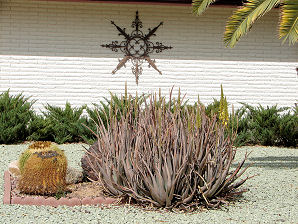Xeriscape Landscape Plants & Flowers
For The Arizona Desert Environment.
Pictures, Photos, Images, Descriptions, & Reviews.
Aloe Vera Or Medicinal Vera, Aloe vera.
We Are Proud Of Our SafeSurf Rating!
Click On Any Of The Following Links By Amazon.Com
For Books, & Videos About Wildflowers Of Arizona & The Southwest USA. No Obligation!
 |
| Aloe Vera Or Medicinal Vera, Aloe vera. |
|---|
 | |
| Aloe Vera | Aloe Vera |
|---|---|
 | |
| Aloe Vera | Aloe Vera |
Aloe Vera.
We wish to thank Wikipedia, the free encyclopedia for some of the information on this page. We share images and information with Wikipedia. Medicinal aloe or Aloe Vera is a clump forming succulent whose fleshy gray - green leaves are arranged in a rosette at the top of a very short stem. The leaves are up to about 18 inches long and 2 inches wide at the base, they are slightly grooved on top, and they end in a sharp point. The leaves have small grayish colored teeth on their margins. The main rosette grows up to about 2 feet high, and the plant produces small offset rosettes. In the winter through the spring, medicinal aloe bears small tubular yellow flowers on branched stalks up to about 3 feet tall. The real Aloe vera has yellow flowers, but many of the clones now available have orange flowers. The clear gel-like sap that oozes from cut aloe leaves has been shown to help burns and wounds heal faster and to reduce the risk of infection. However, there is just about the same amount of scientific evidence that it has no effect! The natural range of Aloe vera is unclear, as the species has been widely cultivated throughout the world. Naturalised stands of the species occur in the southern half of the Arabian peninsula, through North Africa (Morocco, Mauritania, Egypt) as well as Sudan and neighbouring countries, along with the Canary, Cape Verde, and Madeira Islands It is very pool friendly.
Quick Notes:
Height: Height to about 3 - 3 feet. Spreading to about 4 feet.
Flowers: Yellow drooping flowers grow in a long raceme at the top of the flower stalk. On an inflorescence that is branched into 3 to 8 racemes, the racemes sre 8 inches to 16 inches in length. Flowers are 1 inch - 1 1/4 inch in length, tubular in shape and slightly upturned at the mouth.
Flowering Time: Phoenix Arizona, January - July.
Leaves: Smooth gray - green in color, narrow and oblong in shape, the leaf - margins have small, sharp teeth that are red - brown in color.
Stems: Stemless, densely leaved rosette.
Fruit: The fruit is a triangular capsule containing numerous seeds.
Found: Native to Northern Africa, the Canary Islands and the Cape Verde Islands. The USDA claims they are naturalised to the USA (FL, HI, TX), USA+ (PR, VI).
Hardiness:
Soil pH requirements:
Sun Exposure:
Elevation: 0 - 4,870 feet. In Arizona.
Habitat: Sandy or gravelly, well-drained soil. Full Sun. Best with some shade. A Xeriscape Landscape plant.
Miscellaneous: Photos Taken At Sun City, Arizona. March 1, 2006. Photos Taken At Glendale, Arizona Xeriscape Garden. February 15, 2006. It is also sold as aloe bardadensis.
|
We Are Proud Of Our SafeSurf Rating!
Click On Any Of The Following Links By Amazon.Com
For Books, & Videos About Wildflowers Of Arizona & The Southwest USA. No Obligation!
| © 1966 - Present, Audrey, Eve, & George DeLange |
